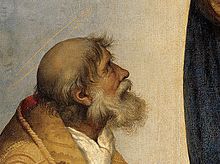Sixtus II.
Sixtus II. († August 6, 258 ) (Xystus) was bishop of Rome from August 30, 257 to August 6, 258 .
Life
His name means: S (e) xtus = the sixth ( Latin ) or (more likely here) Xystus = the smoothed one ( Greek ).
He ended the dispute with the African and eastern communities about the baptism of repentant heretics , his predecessor Stephan had led ( Ketzertaufstreit ). Like all early Roman bishops, he was later placed in the line of popes , although this title was not yet used at the time. As such, he is the first Pope to bear the same name as a previous one.
The numbering of the Pope's name as Sixtus II took place late. According to Greek tradition, his name was probably Xystus . He died a martyr under Emperor Valerian . During the service on the Coemeterium of Callistus , he was attacked and executed together with four deacons.
Adoration
Although he enjoyed the highest veneration of all early martyr popes, the archdeacon Laurentius, martyred after him, has become more conscious of Christianity . The life and work of the two found the highest artistic expression in the Capella Nikolaus' V in the Vatican , while Raffael made Sixtus immortal in the painting of the Sistine Madonna .
His (not required) feast day in the Catholic Church is August 7th, in Orthodoxy it is August 10th. He is one of the so-called canon saints and is mentioned in the First Prayer before the conversion. In the Upper Bavarian pollen field (until the 19th century) there were also pilgrimages in his honor; the local parish church of St. Sixtus still has a relic of the forearm bone.
Sixtus is the patron saint for the good growth of the grapes, on his feast day on August 7th there are grape consecrations. He is also the patron for the flourishing of the beans, for pregnant women and for neck, back and loin pain. His attributes are: purse or piece of money, he is often represented together with Laurentius .
The Sixtus chasuble in Vreden, dating from the 7th to 8th centuries, is named after Sixtus .
literature
- Erich Kettenhofen : Sixtus II. In: Biographisch-Bibliographisches Kirchenlexikon (BBKL). Volume 10, Bautz, Herzberg 1995, ISBN 3-88309-062-X , Sp. 578-582.
- Michael Ott: Pope St. Sixtus II . In: Catholic Encyclopedia , Robert Appleton Company, New York 1913.
Web links
- Sixtus II in the Ecumenical Lexicon of Saints
- Complete works of Migne Patrologia Latina with table of contents
Individual evidence
- ↑ See Jägers, Elisabeth (among others): The Sixtus chasuble in Vreden. Bonn, 1997, ISBN 3-7749-2850-9 , p. 5
- ^ Friedrich Tenhagen: The Sixtuskasel in Vreden. (pdf) In: Collected treatises on the history of Vreden - Contributions to the history and local history of Vreden, Volume 1. Heimat- und Altertumsverein in Vreden, 1939, p. 36 , accessed on November 17, 2018 .
| predecessor | Office | successor |
|---|---|---|
| Stephan I. |
Bishop of Rome (the term Pope was first used after 384) 257–258 |
Dionysius |
| personal data | |
|---|---|
| SURNAME | Sixtus II. |
| BRIEF DESCRIPTION | Bishop of Rome (257-258) |
| DATE OF BIRTH | 2nd century or 3rd century |
| DATE OF DEATH | August 6, 258 |
